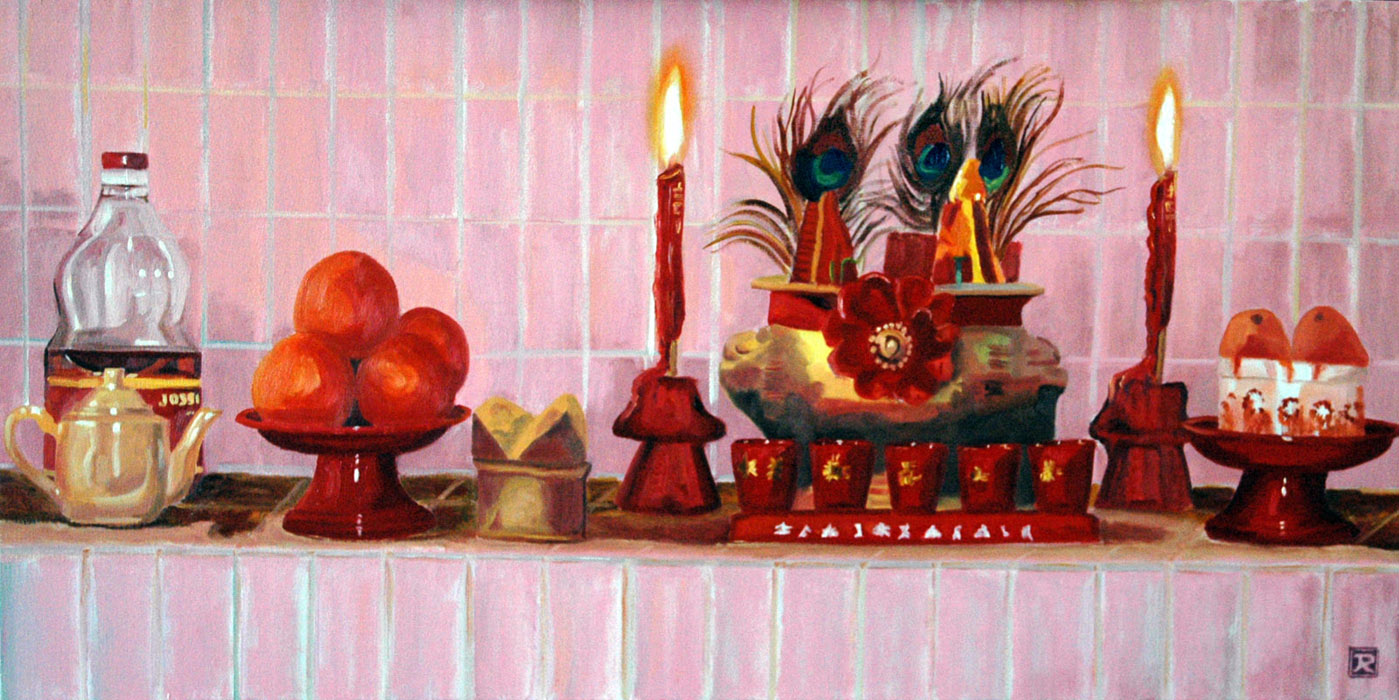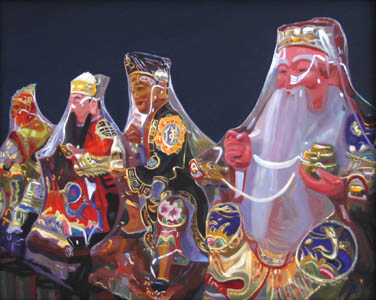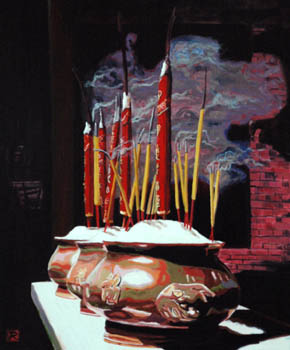
JACK ROOTMAN
Press Release – “Sacred Places –
Culture, Colour and Craft” – the stunning talent of Canadian artist and medical
professor, Jack Rootman – 24th Aug to 3rd Sept 2006
Eye doctor and professor at the University of British Columbia and Vancouver
General Hospital, Jack Rootman now trains his artistic eye on corners of worship
in both Singapore and Mexico. His meticulous and detailed painting style will be
showcased at his first solo painting exhibition in Asia which will be held at
Utterly Art Exhibition Space, 229A South Bridge Road (2nd Level), Singapore
058778 from Thursday 24th Aug to Sunday 3rd Sept 2006. The opening hours are
from Monday-Saturday: 11.30am - 8pm and Sunday: 12pm – 5.30pm. The opening reception will be held on Thursday 24th Aug 2006 7pm. Dr Vivian Balakrishnan, Second Minister for Information, Communication and The Arts will
be the Guest of Honour. Members of the press are most welcome to attend.
Attendance at the exhibition is FREE.
About the exhibition:
The exhibition Sacred Places is a visual log of quiet spiritual corners observed
by Canadian artist Jack Rootman in his many travels. He reveals his fascination
for the pervasive presence of the sacred amidst the mundane, of placement and
juxtaposition in his chance encounters of brightly-coloured objects of worship
in unexpected places. Lovingly crafted or of dignified manufacture, these
corners provide meditative contemplation for the passerby and glorious subjects
for the artist. Sensitively rendered in oils or pastels with attention to the
interplay of light and colour, the paintings may be as transformative and
evocative as the original shrines themselves.
Jack Rootman has participated in 24 group shows internationally and mounted six
solo exhibitions in Vancouver and Adelaide. He has attended courses at the Emily
Carr Institute of Art and Design, Vancouver, the National Academy of Design, New
York, The Art Students League of New York and The New York Academy of Art, and
won a number of awards at several juried shows. He is also Professor of
Ophthalmology and Visual Sciences, and of Pathology at the University of British
Columbia and Vancouver General Hospital. Sacred Places will be his first solo
foray in Asia.

The Artist’s Statement
SACRED PLACES
Culture, Colour and Craft
I have been fascinated in my travels by the ways in which cultural iconography
inserts into our daily lives. This can occur both in the formal and casual
contexts, may be pervasive, and is often unrecognized or subliminal. Because of
this, we often unwittingly celebrate the rituals of different cultures.
For me, I find it also interesting that craft is such an omnipresent messenger,
expressing the sacred and the spiritual through the hands and minds of the
creator, thereby celebrating the rituals of life and sharing them with others.
My observations have made me aware of an almost universal fascination with the
use of bright colour in the making of these objects and their placement in both
private and public spaces.
Often it is spiritual energy that drives the need to communicate a specific view
through craft. For instance, I have taken objects of diverse geographic origin
and displayed them in a similar context to show how they make the mundane
sacred. Take the two objects of devotion that I found in unexpected places –
“Kitchen gods” and “Garage angels”. One I discovered in a quiet laneway in the
heart of Singapore and the other was found tucked away in a parking garage in
Mexico. Both share a need to sanctify the ordinary and provide a reason to stop
and reflect. Both are colourful, arranged with great personal care, and
strategically placed to capture the attention of the passerby or to provide a
place of contemplation for the worker. They reflect our common need for the
spiritual with a tender regard for the mundane places in which it may exist.
I have also tried to show how “manufactured icons” can evoke the spiritual,
sometimes in odd ways or even in odd places, like the “Tree gods” found in an
almost abandoned lot in Singapore. These and similar gods were also seen
awaiting placement in shrink-wrapped anticipation in an emporium where they are
sold. Even here these icons contained within plastic and awaiting exposure exude
a sense of power, reverence and dignity.
Several of the works show aspects of Mexican craft that I found in shops and
markets in Mexico. One is an array of bright handcrafted crosses and the other
is a casual arrangement of both religious and secular objects, conveying a
similar sensibility through colour, craft, and placement in space. As an
example, the unusual juxtaposition of Frida Kahlo as a background to a wooden
sculpture of a priest, adjacent to several Christian icons and behind two wooden
angels struck me as surprisingly harmonious, even though they represent vastly
different worlds and philosophies.
The paintings I did of incense in urns arose from a similar fascination with
context. These pieces are, in my view, especially transformative and evocative
of not only place but time through the ancestral connotation of the burning
incense and smoke-filled background. The bright shafts of light serve only to
emphasize and illuminate these striking juxtapositions.
My artistic journey has been driven by the natural curiosity of an observer and
by an interest in spiritual values. As I became committed to artistic
expression, I was attracted to landscape and natural still life, particularly of
British Columbia but also from my travels. My media choices started with
watercolor then grew to include ink, gouache, gesso, acrylic, oil, and collage.
I am interested in the interplay of light and color in nature, and stylistically
attracted to the romantic realist mode. Experimentation with texture produced by
manipulating and mixing media is a major challenge. Art brings a joyful focus
into life, creating a sensitivity to our environment, the color, and textures of
the natural world. I have a particular fascination with interpreting design,
contrast, and texture. I have also become interested in scale, painting from
miniature to mural sizes.
If I am to paint from the heart, mankind must be at the core of the narrative.
My principal goal is to represent some of the universals in human behavior and
interaction, with special emphasis on those moments that touch the spirit of
humanity.
Techniques
I have employed two techniques in preparation of this exhibition. The first is
the use of traditional oils on canvas or wood over an acrylic underpainting. The
oil provides luminosity, historical reference, texture, and permanence. The
second medium that I have used is handmade dry pastel on board. I used wooden
board in order to avoid a paper surface, which would be vulnerable in a humid
climate. These boards are specifically and archivally designed for this
exhibition so that they can be mounted behind glass with an air gap. Pastel also
provides significant permanence; indeed, the Pastel Society of America suggests
that pastels are more archival than oils, as exemplified by work done in the
last century by Degas. I have also visited a recent exhibition of the artist,
Rosalba Carriere, from the 1730s in which his pastels were remarkably vibrant
and well preserved as if they had been done yesterday. I wanted to include some
pastels because of their brightness and for the felt-like and velvet quality
produced by the multiple layers of medium used.
COMMENTARY
Tonight, we witness the artistic
accomplishments of Jack Rootman in his first solo show in Asia: Sacred Places –
Culture, Color and Craft.
Jack has always been an artist. He chose to practice as an orbital surgeon
because he realized he was blessed with a pair of steady hands and he wanted to
fulfill his gift.
Art was the love which grew stronger through the years. After he was stricken by
a debilitating illness, he immersed himself further in art-making. For a year,
he trained in New York at the National Academy of Design, The Arts Student
League, and the Academy of Art. He has since held 6 solo shows and 24 group
shows around the world. And he has received the top award in the 50th Federation
of Canadian Artists show for his work “Ocean’s Edge”.
In combining his practices of Art and Ophthalmology, Jack created the Lester
Jones Award-winning “Orbital Surgery” - a landmark textbook on orbital anatomy
based on an artist’s perspective.
Jack’s art goals have been depicting human behavior and interaction, and
capturing the human spirit.
In Sacred Places, Jack takes us to a journey across the world in the eyes of a
man open to spirituality. With him, we find at unexpected places and quiet
corners, brightly-colored mundane objects of worship that have been reverently
assembled by devotees. Whether these spiritual sanctuaries at ordinary places
are in Singapore, Mexico, or Vietnam, they represent a universal need of humans
to be close to the divine.
These ordinary places in Singapore include the parking lot at Flanders Square,
the loading bay at Amara Hotel, and an emporium at Rochor Road. These same
places are extra-ordinary in that private spiritual spaces have been carved out
from public open spaces.
In Jack’s works, we see his mastery of pastel and oil, and his appreciation of
contrast, texture, and color.
In Jack’s works, we draw a picture of a man who is sensitive and observant,
analytical and imaginative, passionate and adventurous.



In waiting
SACRED PLACES
CULTURE,COLOUR & CRAFT
oils and pastels by Canadian artist
JACK ROOTMAN
Gallery Tour and Talk by the artist
SATURDAY 26th AUG 2006 3PM
Utterly Art Exhibition Space (above Teck Soon Medical Hall,
opposite the Sri Mariamman Temple, Pagoda St Entrance)
229A South Bridge Road (2nd Level) Singapore 058778
Tel: 6226 2605 Fax: 6226 2645
Mon-Sat 11.30 am - 8 pm Sun 12 noon - 5.30 pm
The exhibition runs to SUNDAY 3rd SEPT 2006 .